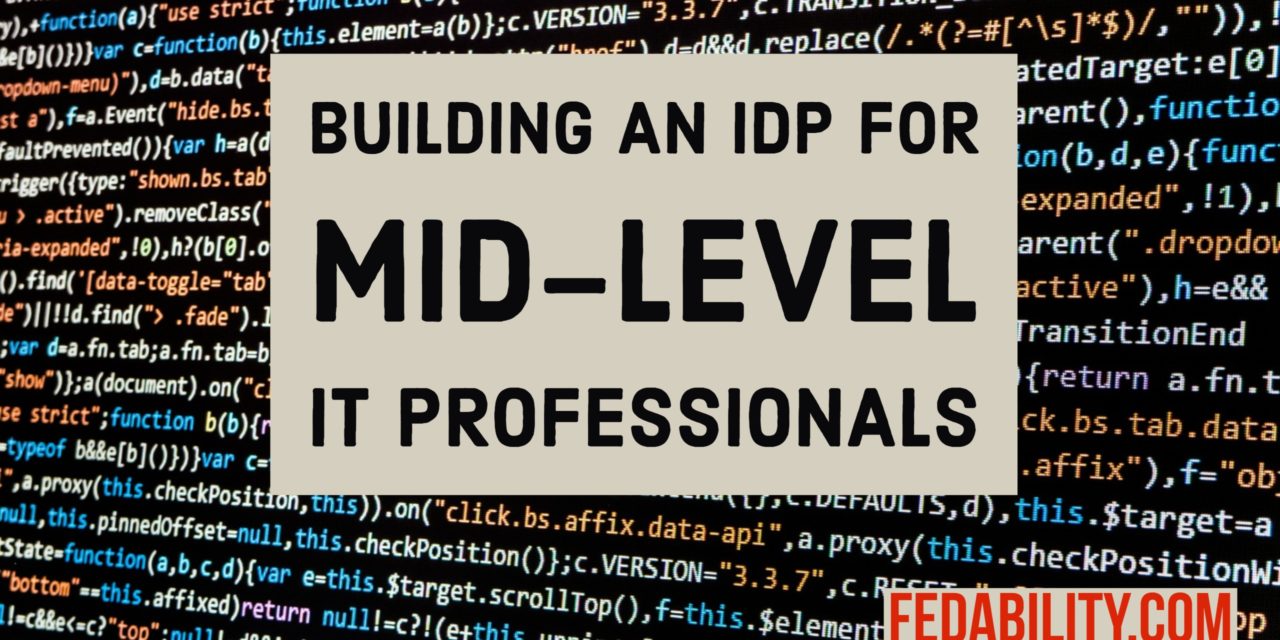Is there much difference from being in a GS12 position versus a GS13? Well, if you ask some trying to get into a GS13 position, my guess is they would say yes. Oftentimes, it’s a mystery of what makes the difference from seemingly similar positions. That’s because moving up in one’s career is a jumble of skills, hard work, networking, and good timing. But, there are some solid places to start if you are looking to create an IDP for IT professionals. In this post, I will focus on the core skills that distinguish someone at a GS12 position from those looking to move into a GS13 position. As a bonus, I’ve also created a template idp for mid-level IT professionals.
Not an IT professional? That’s ok – many of these skills will generalize. Or, you could check out one of our prior posts: Professional development for when you’re feeling lost.
Looking for help going from an entry level position (GS9) to a mid-level (GS12) IT position? Check out last week’s post which includes a template IDP for entry level IT professionals looking to move up.
Where to start building a template IDP for mid-level IT professionals
Many people start with looking around at those who are in the positions that they want to be in. They will try to figure out what that person does, and then attempts to emulate them. There’s some challenges with that approach.
- The person who is in the desired position may not be performing effectively. Thus, if you’re trying to learn from them – you might actually be learning bad habits.
- It’s hard to figure out what the skill differences are when it’s just one grade higher than where you are already.
The first place to start is to remember that there’s 3 areas that anyone will need to be strong in to be effective in their position. These professional development goals need to include: technical, professional, and problem-solving skills. Take a look at our prior post to get a deeper understanding of why these three areas are most critical.
The second place to start is at the source, Office of Personnel Management (OPM). You see, OPM is the agency that sets the rules for what it means to be a GS-12 versus a GS-13. So, rather than guessing what your colleague who is at a higher grade is doing – at the risk of the challenges I mentioned above – go to the source.
Differentiating between a GS12 and a GS13
What is the differences in skills needed for an IT professional at the GS12 level versus the GS 13? Well, I started with the cyber security competency model and started comparing the general (not the technical) skills. Going back to our 3 professional goal model, these general competencies would fall into the professional and problem-solving areas.
Needed skills in a template IDP for mid-level IT professionals
There were 3 areas of skills differences between a GS12 and a GS13 according to OPM’s competency model of IT cybersecurity professionals. These included:
- Conflict management
- Partnering
- Planning and evaluating
Building a template IDP for mid-level IT professionals
As compared to competencies that were needed to move from an entry-level IT position to a mid-level IT position – I have to admit these competencies are a it more challenging to develop. But, that’s to be expected at higher GS levels.
So, where do you start?
In building your template IDP for mid-level IT professionals I suggest keeping in mind that these are challenging competencies. These competencies will require more creativity to develop. And, these competencies will be not only harder to master – but more challenging to observe. In short, there is no silver-bullet.
I have faith, however, that you can do it. And, I’m here to help.
Conflict management
According to OPM, conflict management is defined as: Manages and resolves conflicts, grievances, confrontations, or disagreements in a constructive manner to minimize negative personal impact.
This is a competency that most people struggle with to do well. In fact, those who feel the least comfortable with conflict often tell me it’s because they are worried about hurting their relationship with the other party. I argue, that not being willing to disagree (or not building your skill in disagreeing effectively) will do more harm to the relationship. Those who ‘enjoy’ conflict often tell me that it’s a necessary evil to getting the job done. In reality, too often these conflict-lovers tend to roll over those who conflict-haters. So, I wouldn’t exactly call this effective conflict management either.
My go-to recommendation for this competency is to recommend Crucial Conversations Tools for Talking When Stakes Are High, Second Edition.
Why? Because we seldom experience full-out yelling-matches at work – which is what I think of when I think ‘conflict’. It’s usually more about having tough conversations with another person. This might be disagreeing with them on a topic you both feel strongly about. Or it might be holding someone accountable for not meeting a mutually agreed upon deadline. It might even be giving someone constructive feedback.
Whatever the case may be, Crucial Conversations is a book that can help you through those conversations. I highly recommend you adding it into your template IDP for mid-level IT professionals.
Partnering
OPM defines partnering as: Develops networks and builds alliances; collaborates across boundaries to build strategic relationships and achieve common goals.
Ah, networking. It’s another competency that people either love or hate. I believe this is because networking has a negative reputation. When done with intention it can feel inauthentic. But, it does not have to be this way.
My first recommendation is to start with LinkedIn. Update your profile. Then, update your connections. Link to those you know from prior jobs, as well as those you work with now. It’s one of the most simple ways to ‘expand your network.’
But, you can’t stop there. I challenge you to check in on LinkedIn at least 2x per week and comment on an article that someone in your network has posted. This has a dual benefit. First, you are likely learning things from the articles you’re reading. Second, you’re starting to reinforce that network and building alliances.
I also recommend checking out Political Savvy: Systematic Approaches to Leadership Behind the Scenes. This is a book I’ve used in teaching leadership classes. And, what I like the most about it is that it speaks to the kinds of people you have in your network and how to build a coalition.
Planning and evaluating
OPM defines planning and evaluating as: Organizes work, sets priorities, and determines resource requirements; determines short- or long-term goals and strategies to achieve them; coordinates with other organizations or parts of the organization to accomplish goals; monitors progress and evaluates outcomes.
Now this is one of the few areas where I’d recommend formal training. To start with, look into some basic project management classes.
BUT! I encourage you to resist seeking a Project Management Professional (PMP) certificate unless your position really requires it. In my opinion, the certificate is valuable for understanding the processes and tools of professional project managers. However, the certificate does little to help someone manage their day to day priorities and resource requirements.
That said, you might check out Project Management for the Unofficial Project Manager: A FranklinCovey Title. It’s a balance between basic project management skills and the official “PMP” certification. Also, since you’re in IT, it might be worth taking a look at something like Scrum Basics: A Very Quick Guide to Agile Project Management
.
Challenge to take action to use the template IDP for mid-level IT professionals
- Download the Fedability template IDP for mid-level IT professionals.
- Complete the template by selecting up to 1-2 competencies.
- Identify a couple methods to develop the competencies you picked. Not sure how to do it? The template offers a list of methods to develop your skills. Or, you could try googling it. “Ideas to build my network” Read a few ideas that pop up. Or, send me an email and we can talk through a couple ways to build those skills.
- Tell us what you come up with in the comments below!









